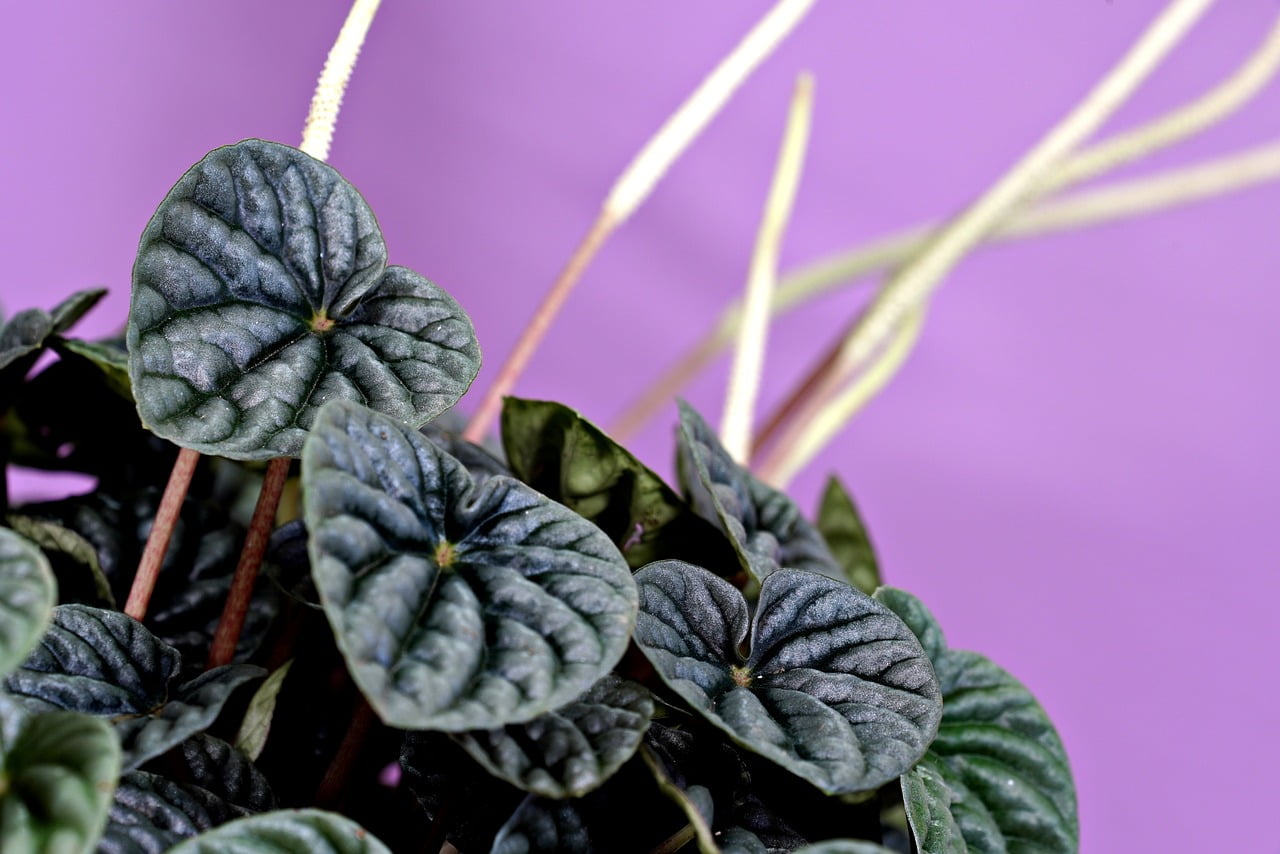Peperomia plants are beloved for their diversity and easy maintenance, making them a favorite among both seasoned and novice plant enthusiasts.
In this guide, we’ll explore some of the most popular Peperomia plants, providing concise descriptions along with their pros and cons.
Additionally, we’ll delve into essential care tips, propagation techniques, and where to acquire these charming plants.
Origins and History of Peperomia Plants
Peperomia plants, with their origins in the rainforests of Central and South America, have captivated plant enthusiasts for centuries.
Their journey into cultivation began in the early 19th century, as botanists and plant enthusiasts explored the rich biodiversity of these regions.
The name “Peperomia,” derived from the Greek words “peperi” (pepper) and “homoios” (resembling), reflects their close resemblance to true pepper plants.
Also Read: Atis Fruit: Their Origin, Characteristics, Nutritional Benefits, and Cultivation
Initially recognized for their ornamental foliage, Peperomia plants gained popularity during the Victorian era in Europe and the United States. Their unique textures, shapes, and patterns contributed to their allure, making them sought-after additions to indoor gardens.
Over the years, plant breeders have introduced numerous cultivars, enhancing the diversity within the Peperomia genus. From the classic Watermelon Peperomia to the more recent variegated varieties, each type has its own story in the broader narrative of indoor horticulture.
Popular Peperomia Plant Types and Varieties
Peperomia plants, belonging to the Piperaceae family, are a diverse and captivating group with over 1,500 known species.
Below are some of the famous Peperomias plants that have captivated plant enthusiasts worldwide.
Raindrop Peperomia (Peperomia polybotrya)
The Raindrop Peperomia, scientifically known as Peperomia polybotrya, delights with its heart-shaped leaves resembling glistening raindrops.
Native to South America, this variety thrives in the understory of rainforests, adapting well to lower light conditions.
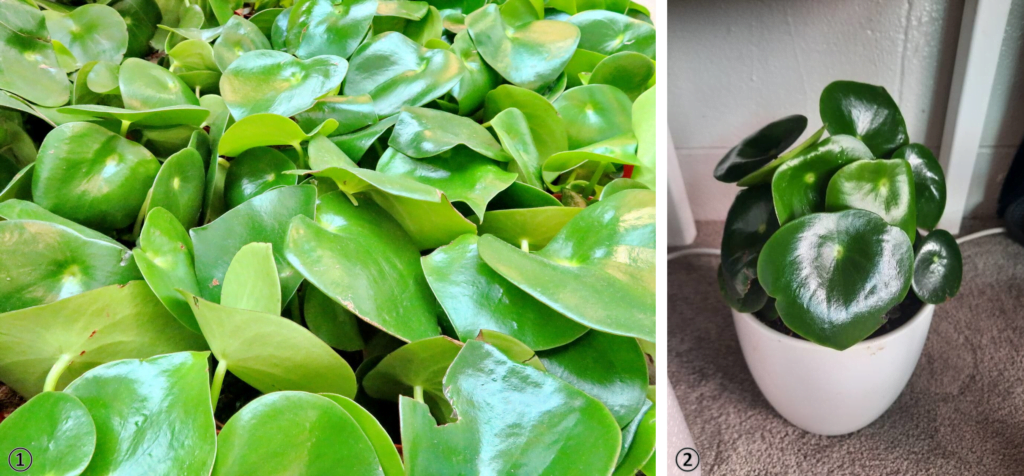
② Peperomia polybotrya in a glazed white pot. © Karina Maru (cc-by-sa) – Nov 22, 2021 / Pl@ntNet
Its compact size makes it perfect for small spaces, and it’s resilient to neglect, bouncing back from occasional lapses in care.
However, overwatering can be its Achilles’ heel, leading to root rot if not managed carefully. For optimal growth, provide well-draining soil, and let the top inch dry out before watering.
Watermelon Peperomia (Peperomia argyreia)
The Watermelon Peperomia, scientifically named Peperomia argyreia, earns its moniker from the striking watermelon-like pattern adorning its leaves.
Originating from the rainforests of South America, this Peperomia plant is celebrated for its adaptability to various light conditions, making it a versatile choice for different spaces.
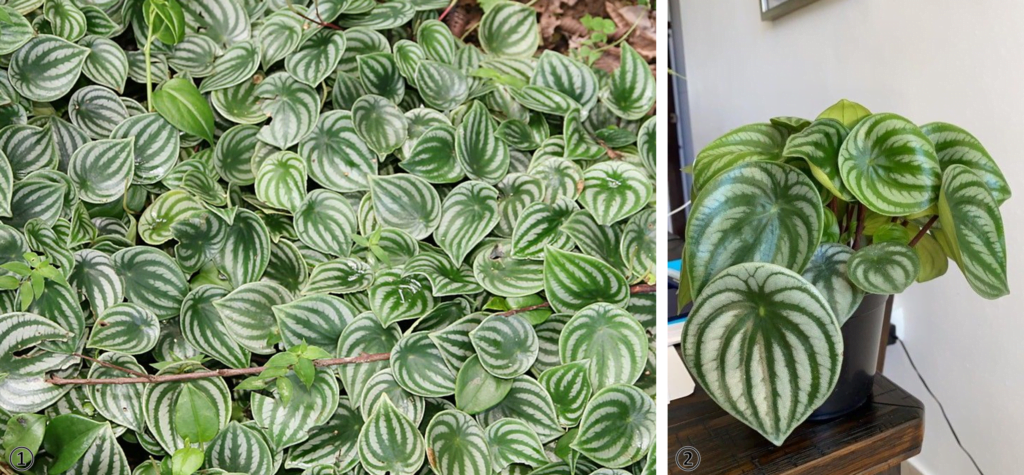
② Peperomia argyreia in a plastic black pot. © Franqui Migdalia (cc-by-sa) – May 1, 2020 / Pl@ntNet
Its low-maintenance nature adds to its allure, but vigilance against mealybugs is crucial for its well-being.
Regular inspection of the foliage and immediate treatment of any pests will ensure the Watermelon Peperomia remains a vibrant and healthy addition to your indoor garden.
Radiator Plant (Peperomia caperata)
The Radiator Plant, scientifically known as Peperomia caperata, stands out with its textured and crinkled leaves, adding a touch of sophistication to any indoor garden.
Hailing from the rainforests of South America, this variety boasts adaptability to lower humidity conditions, making it an excellent choice for various climates.

② Peperomia caperata ‘Schumi Red’ has rich deep purple-reddish leaves. © Lazaregagnidze, CC BY-SA 4.0, via Wikimedia Commons
While it’s generally low-maintenance, sensitivity to overwatering calls for a balanced watering routine to prevent stress on the peperomia plant.
The Radiator Plant’s unique appearance and resilience make it a captivating addition to both beginner and seasoned plant enthusiasts’ collections.
Emerald Ripple Radiator Plant (Peperomia caperata Rosso)
The Emerald Ripple Radiator Plant, scientifically called as Peperomia caperata Rosso, with its vibrant red undersides, adds a pop of color to indoor spaces.
Hailing from the tropical regions of Central and South America, this variety adapts well to different light conditions.
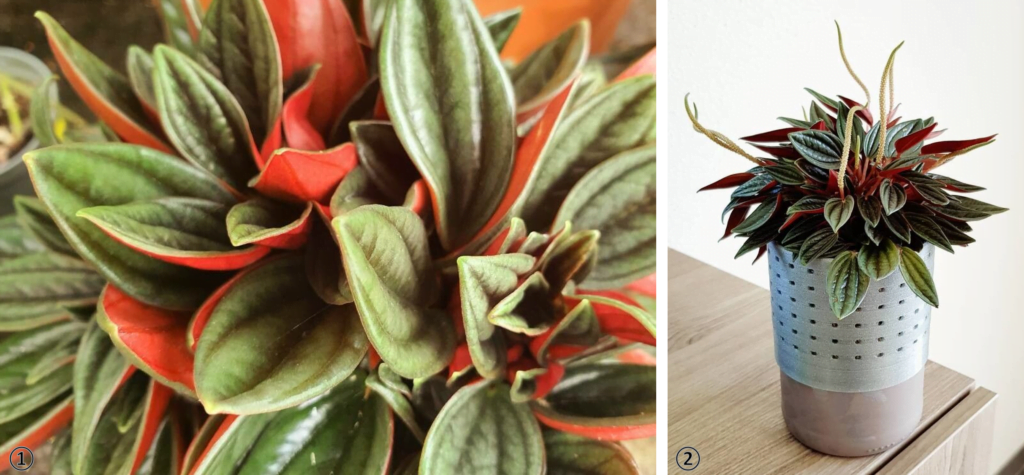
② Beautiful Peperomia caperata ‘Rosso’ with flowers resembling long narrow white stalks. © dragonink (cc-by-sa) – May 30, 2020 / Pl@ntNet
However, it exhibits a preference for higher humidity levels, requiring additional attention during drier periods.
Its unique aesthetic and adaptability make the Peperomia Rosso a captivating choice for plant enthusiasts looking to infuse color and vibrancy into their indoor garden.
Baby Rubber Plant (Peperomia obtusifolia)
The Baby Rubber Plant, scientifically known as Peperomia obtusifolia, charms with its thick, glossy leaves, reminiscent of a rubber tree.
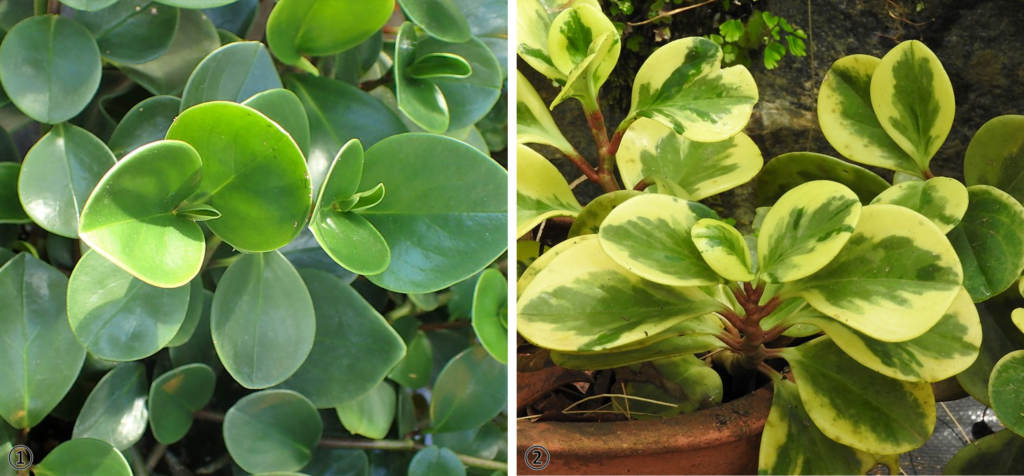
② Piperaceae-leaves light green variegated with milky green and margin inward, broad area of creamy white. © Yercaud-elango, CC BY-SA 4.0, via Wikimedia Commons
Originating from Central and South America, this Peperomia plant is lauded for its adaptability to lower light conditions, making it a popular choice for indoor environments. Its air-purifying qualities add a functional aspect to its aesthetic appeal.
However, to keep this variety thriving, it’s essential to regulate watering carefully, as overwatering can lead to sensitivity and potential issues with root health.
Ruby Glow Peperomia (Peperomia graveolens)
The Ruby Glow Peperomia, scientifically known as Peperomia graveolens, earns its name from the captivating ruby-red undersides of its succulent-like leaves.
Originating from the mountains of Ecuador, this variety showcases adaptability to semi-arid conditions, making it a unique addition to the Peperomia family.

② Piperaceae-leaves light green variegated with milky green and margin inward,broad area of creamy white. © Yercaud-elango, CC BY-SA 4.0, via Wikimedia Commons
Its compact size and distinctive appearance make it an ideal choice for succulent enthusiasts seeking a touch of elegance in their indoor garden.
While it can tolerate lower light conditions, providing bright, indirect light enhances its vibrant coloration.
Careful attention to watering and well-draining soil ensures the health and longevity of the Ruby Glow Peperomia in your plant collection.
Variegated Peperomia Plants
Variegated Peperomia plants stand out in the world of indoor plants due to their rarity and the captivating beauty they bring to any space.
Their unique color patterns make them a sought-after gem among plant enthusiasts, adding an element of exclusivity to your collection.
Among the myriad Peperomia varieties, the variegated ones are considered treasures for their scarcity and the striking aesthetic they lend to indoor gardens.
Rarity in Diversity
The rarity of variegated Peperomias is amplified by the fact that not all Peperomia species exhibit this unique coloration. Among the various Peperomia plant types, only a select few showcase the distinctive variegation patterns.
One of the most coveted varieties is the Peperomia obtusifolia ‘Variegata,’ celebrated for its elegant creamy-white edges on glossy green leaves. This rarity enhances its desirability, making it a prized possession for plant collectors looking to cultivate a diverse and unique indoor oasis.
Popular Varieties
Several popular variegated Peperomia plant varieties have captured the hearts of plant enthusiasts worldwide.
The Peperomia clusiifolia ‘Rainbow’ is a stunning example, featuring a mesmerizing mix of green, cream, and pink hues that resemble a botanical rainbow. This variety not only adds color to your space but also infuses it with an energetic and vibrant atmosphere.
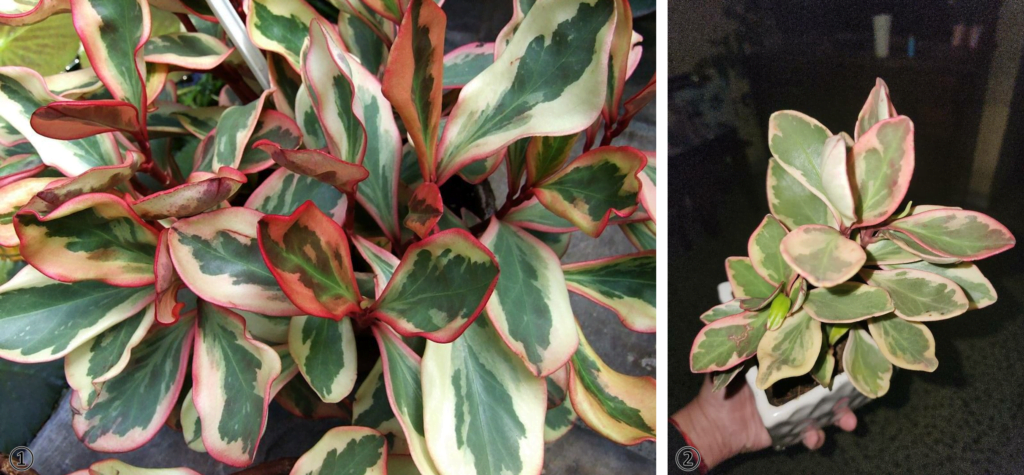
② Showing the cream and pink hues of the leaves of Peperomia clusiifolia ‘Rainbow’, also called peperomia ginny, in a square glazed pot. © Javier Castro (cc-by-sa) – Dec 13, 2022 / Pl@ntNet
Another beloved option is the Peperomia argyreia ‘Watermelon Variegata,’ a whimsical take on the classic Watermelon Peperomia. With its variegated watermelon-like pattern and cream accents, this variety is a visual delight, further contributing to the rarity and allure of variegated Peperomias.
Challenges and Delights of Rarity
While the rarity of variegated Peperomia plants makes them coveted additions to any plant collection, it also presents challenges in terms of availability. Locating these unique varieties can be a quest, often requiring a keen eye and persistence.
Nurseries that specialize in rare and exotic plants or dedicated plant collectors may be the go-to sources for acquiring these prized specimens.
The pursuit of rare variegated Peperomia plants adds an exciting dimension to the journey of cultivating a distinctive and visually captivating indoor garden, where each variegated leaf tells a rare and beautiful story.
Care and Maintenance
Successfully cultivating a thriving indoor garden of Peperomia plants involves a thoughtful approach to their care and maintenance. These adaptable and resilient plants have specific needs that, when met, result in lush foliage and vibrant colors.
In this section, we’ll delve into the essential aspects of caring for your Peperomia plants, covering everything from soil requirements to pest management.
- Soil:
- Use well-draining soil to prevent waterlogging and root rot.
- A mix of peat moss, perlite, and orchid bark is suitable for Peperomias.
- Watering:
- Water when the top inch of soil feels dry to the touch.
- Avoid overwatering, as Peperomias are susceptible to root rot.
- Light:
- Place in bright, indirect light, although they can tolerate lower light conditions.
- Variegated types may benefit from slightly brighter light for optimal coloration.
- Temperature and Humidity:
- Keep Peperomias in a warm environment, ideally between 65-75°F (18-24°C).
- They adapt well to average household humidity but appreciate higher levels.
- Dusting and Pruning:
- Regularly dust the leaves to maintain optimal photosynthesis.
- Prune to control size and promote bushier growth.
- Fertilization:
- Fertilize sparingly during the growing season (spring and summer).
- Use a balanced liquid fertilizer at half the recommended strength.
- Pest Control:
- Regularly inspect for pests, especially spider mites.
- Treat infestations promptly with insecticidal soap or neem oil.
By understanding and implementing these simple care guidelines, you’ll foster an environment that encourages the health and longevity of your Peperomia plants, ensuring they remain a source of joy and beauty in your home.
If you are looking for an extensive care guide for your beloved succulents, you may want to read Cactus and Succulent Care Tips Guide for Beginners.
Propagation of Peperomia Plants
Whether you’re eager to share your beloved plants with friends or expand your indoor garden, understanding the methods of propagating Peperomia plants is a valuable skill.
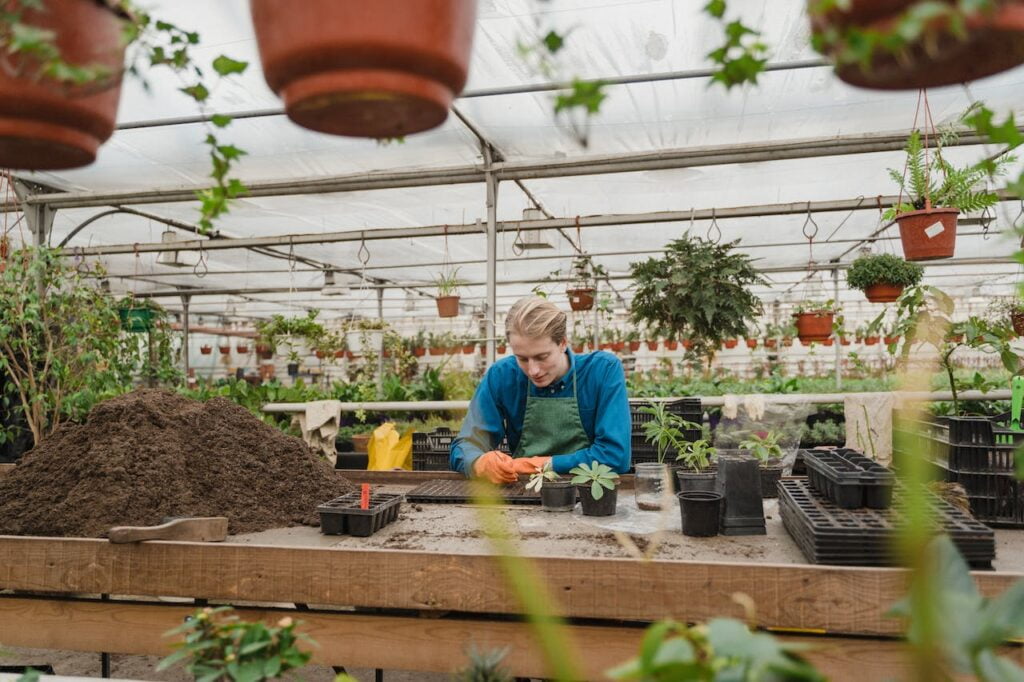
In this section, we’ll explore the two primary techniques—leaf cuttings and stem cuttings—guiding you through the steps to foster new, thriving Peperomia offspring.
Leaf Cuttings
- Selecting a Healthy Leaf: Begin by choosing a healthy, mature leaf from your Peperomia plant. Ensure it is free from any signs of damage or disease. The selected leaf will serve as the foundation for your new plant.
- Allowing Callus Formation: After carefully snipping the chosen leaf from the plant, allow it to sit in a dry, shaded area for approximately 24 hours. This brief waiting period encourages the cut end to form a callus, protecting it from potential infections during the propagation process.
- Planting the Leaf: Once the callus has formed, plant the leaf in a well-draining propagation mix. A combination of peat moss and perlite works well. Insert the cut end into the soil, burying it just deep enough to provide stability.
- Maintaining Humidity: Create a humid environment around the planted leaf to enhance its chances of successful propagation. Cover the pot with a clear plastic bag or use a propagation tray with a humidity dome. This helps retain moisture and promotes root development.
- Monitoring and Transplanting: Keep a close eye on the planted leaf, ensuring the soil remains consistently moist but not waterlogged. Once roots are established, typically within a few weeks, transplant the new Peperomia into its individual pot with standard potting mix, gradually acclimating it to its new environment.
Stem Cuttings
- Selecting a Healthy Stem: Choose a healthy stem with at least a couple of leaves attached. Ensure it’s free from any signs of pests or diseases. The selected stem will serve as the basis for your propagated Peperomia.
- Trimming and Callus Formation: Trim the selected stem just below a node, as this is where roots will develop. Allow the cut end to dry and form a callus for a day or two. This step reduces the risk of infections during the propagation process.
- Planting the Stem: Plant the trimmed stem in a well-draining mix, similar to the one used for leaf cuttings. Insert the cut end into the soil, burying it deep enough to provide stability while keeping a node above the surface.
- Creating a Humid Environment: Similar to leaf cuttings, create a humid environment around the planted stem. Cover the pot with a clear plastic bag or use a propagation tray with a humidity dome. This encourages the development of roots and ensures a successful propagation process.
- Root Development and Transplanting: Monitor the planted stem for root development. Once roots are well-established, usually within a few weeks, transplant the new Peperomia plant into its individual pot with standard potting mix. Gradually acclimate it to its regular growing conditions.
Propagation Tips
- Timing: Propagation is most successful during the plant’s active growing season, typically in spring or early summer.
- Temperature: Maintain a warm environment for optimal root development, aiming for temperatures around 70-75°F (21-24°C).
- Light: While high light is not necessary during the propagation phase, ensure the propagated Peperomia receives indirect light to encourage growth.
By embracing the propagation process, you not only multiply the beauty of your Peperomia family but also embark on a rewarding journey of nurturing new life within your green haven.
Common Problems of Peperomia Plants: Troubleshooting and Solutions
Peperomia plants, known for their resilience and adaptability, can sometimes encounter issues that impact their overall health. Recognizing and addressing these common problems promptly is crucial for maintaining a thriving indoor garden.
Overwatering
One of the most frequent issues with Peperomias is overwatering. These plants prefer slightly drier conditions and are susceptible to root rot if their soil remains consistently soggy.
To address this problem, adjust your watering routine, allowing the top inch of soil to dry out before watering. Ensure that the pot has proper drainage to prevent water accumulation at the bottom.
Root Rot
Root rot can occur if the plant’s roots are consistently in contact with excessive moisture. To prevent this issue, use well-draining soil and provide adequate drainage in the pot.
If you notice signs of root rot, such as wilting or yellowing leaves, take immediate action by trimming affected roots, repotting the plant in fresh soil, and adjusting your watering habits.
Pests
Peperomias are generally resistant to pests, but occasional invasions can occur. Common pests include spider mites and mealybugs. Regularly inspect the undersides of leaves for webbing or cotton-like clusters.
If pests are detected, treat the affected plant with insecticidal soap or neem oil. Isolating the infested plant temporarily can prevent the spread of pests to other nearby plants.
Yellowing Leaves
Yellowing leaves can be a sign of various issues, including overwatering, nutrient deficiencies, or pests. Evaluate your watering habits, ensure proper fertilization during the growing season, and inspect the plant for pests.
Adjusting care based on the specific needs of the Peperomia type can help restore the vibrancy of the foliage.
Lack of Humidity
While Peperomia plants can adapt to average household humidity, some varieties, especially those with variegated leaves, may appreciate higher humidity levels.
To address this, mist the plants occasionally, place a tray of water near them, or group them with other plants to create a microclimate with increased humidity.
Sunburn
Certain Peperomia varieties are sensitive to direct sunlight, which can lead to sunburn, manifesting as brown or scorched patches on the leaves.
If your plant shows signs of sunburn, move it to a location with filtered or indirect light to protect it from harsh sun exposure.
Soil Compaction
Over time, the soil in the pot may become compacted, hindering water drainage and root aeration.
Periodically repot your Peperomia plant, refreshing the soil and inspecting the roots for any signs of issues. Use a well-draining mix to maintain optimal soil conditions.
By staying vigilant and addressing these common problems promptly, you can ensure that your Peperomia plants remain healthy, vibrant, and a source of joy in your indoor garden.
Tip: Regular observation, proper care adjustments, and timely interventions are key to maintaining the well-being of these charming houseplants.
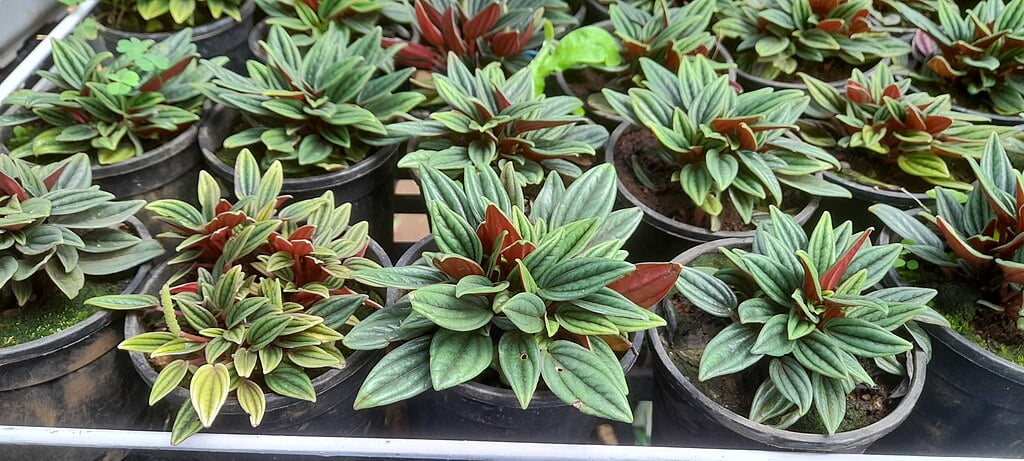
Where to Get Peperomia Plants
Local nurseries, online plant shops, and even community plant swaps are excellent sources for Peperomia plants. Ensure the source provides healthy and pest-free specimens.
Consider joining plant enthusiast communities for potential trades or purchases from fellow plant lovers.
Conclusion
In conclusion, Peperomia plants offer a delightful array of choices for plant enthusiasts.
Understanding the specific characteristics, care requirements, and propagation techniques for each type ensures a thriving indoor garden.
Whether you’re a seasoned plant parent or just starting, these charming plants are sure to bring joy and greenery to your space.
Also Read: Elevate Your Space: A Guide to Best Tall Indoor Plants
Well, what do you think about the article?
Did you enjoy reading “Peperomia Plants 101: Care, Maintenance, and Propagation“? We really hope that you have enjoyed this article. If you have any thoughts or comments about this post, please feel free to share them in the comment section below. We appreciate your feedback and would be glad to hear from you.
To see more content like this check the gardening section of Money For My Beer.

Lara is a freelance content writer and a cat mom to three furbabies, Mizu, Haru and Sora.
She graduated with a Bachelor’s Degree in Architecture and is a registered and licensed Architect. Aside from writing, she is fond of growing cacti and succulents and is a DIY type of girl.
During her free time, she engages herself in water-colouring and crocheting, while catching-up with an old tv series she just discovered. Lara loves to explore new places, but most of the time stays in her hometown province, reading historical romance novels over a cup of coffee – or matcha.

